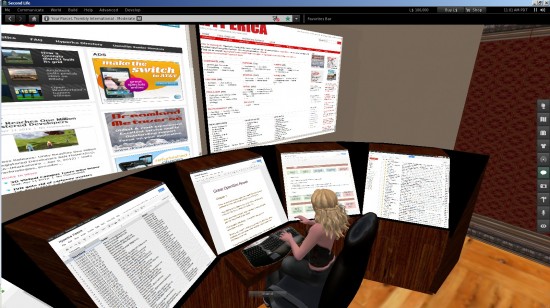Like many folks, I started out in OpenSim using Hippo, then graduated to Imprudence when Hippo was no longer supported.
Today, Imprudence is still the recommended viewer on many grids, including OSgrid.
Then, because I wanted mesh and media-on-a-prim, I started using the official Second Life viewer. It took a little fiddling to get it to log into OpenSim grids, but media-on-a-prim was important to me, so it was worth it.
But my recommendation is that grids consider switching their recommended viewers to Firestorm, instead. I recently switched, and I’ve been happy with the experience.
Here are some reasons why.
Firestorm is a modern viewer
It’s based on the V3 Second Life viewer, which means it supports mesh and media-on-a-prim, modern outfits, the new floating menus — all the latest bells and whistles.
It can take a little time to get used to the new interface, but the biggest problems people had with it when it first came out have been fixed, and it’s now pretty usable. For example, you can move buttons around to where you want them on the screen. I never use the camera view button, so I get rid of it, but I like having the inventory, map, and outfits button on the right side of the screen, so that’s where I put them.
Mesh support is also nice. Even if you never plan to upload a mesh object, it’s good to be able to see the mesh objects that other people have uploaded. Plus, if someone is wearing mesh clothing, you don’t have to see them naked. Which could get awkward.
Finally, my favorite feature, media-on-a-prim. It allows folks to put any Website on any surface. You could play videos, show slides, collaboratively edit Google Spreadsheets or text documents, sell stuff directly from your Website. And you could use it more creatively, as well. For example, you could put a link to a Webpage on any face of a prim, to create easy-to-update virtual books, role playing guides, animated talking heads, interactive maps… there are a lot of possibilities there that haven’t yet been explored.
I use media-on-a-prim to set up a virtual control room in my company office. I can see my email inbox, status indicators for all the Hyperica gates, latest visitor reports, and all other data I need to work in-world.

Again, even if you personally don’t use media-on-a-prim, it’s just too nice a feature for other people to ignore. So, over time, you might be missing out on some functionality.
And there are some more features in the latest viewers, aimed at improving the quality of the experience, stability, speed — by sticking with an older viewer, you’re missing out on all the good stuff that’s coming along. Want more details? Just check out the change log from their August update.
Firestorm is actively maintained
If you to go the viewer’s official website you’ll see regular software updates and news posts.
By comparison, the last stable release of Imprudence came out in the fall of 2010, and the last beta release in the fall of 2011.
Activity is contagious. The fact that new updates of Firestorm come out regularly inspires other developers to find and fix bugs, and to add new features. After all, why bother contributing code to a dead project, where your fix will never see the light of day?
Plus, the fact that developers are actively working on the viewer means that there’s a possibility of hiring them to do custom work if you need to, for a company, school, or commercial grid. Sure, there are still developers who know their way around Imprudence but those guys are getting harder and harder to find.
Firestorm supports OpenSim
This is a big deal. Last spring, Linden Lab announced a new licensing policy, in which viewer developers who wanted the cool new pathfinding code from Havoc would have to drop support for OpenSim. Viewers had the option of not adding the new code, of focusing exclusively on Second Life, focusing just on OpenSim, or releasing two versions of their viewer — one for OpenSim and one for Second Life.
The Firestorm team opted for option number four, and decided to fork their viewer code.
Meanwhile, Second Life cut off OpenSim access via its official viewer in August. As a result, users who want to see meshes and media-on-a-prim in OpenSim can’t use the Second Life viewer anymore. Many grids reacted immediately, no longer recommending the use of the official Second Life viewer to their residents. Kitely, for example, used to allow the use of the official Second Life viewer as one of the viewers that could be used to access their grid through the proprietary Kitely plugin. Instead, Kitely now has Firestorm as its recommended viewer, and eight other viewers, including Imprudence, as possible alternatives.
The Firestorm team has already added some OpenSim-friendly features to their viewer, and opened an office on OSgrid, the largest grid on the OpenSim platform.

For example, one major difference between accessing Second Life and accessing OpenSim is that there is just one main Second Life grid and more than 200 different OpenSim grids — and the number is growing quickly. Almost half of these grids are not hypergrid-enabled, and require users to create new accounts and log in directly. Sure, a lot of those closed grids are private school or company grids, but there are also some large commercial grids on the list, including InWorldz, Avination, and Kitely. This means that OpenSim users need a convenient way to switch between grids.
Another OpenSim-specific issue is hypergrid teleports themselves. Since grids can choose any coordinates they want for their regions, users sometimes have to jump large distances to travel between grids, or travel between two regions with exactly the same coordinates. This isn’t possible in Second Life, so the fact that these kinds of teleports fail isn’t a problem for Second Life-only viewers — but a significant inconvenience for OpenSim users.
Similarly, OpenSim allows megaregions, megaprims, region and inventory exports, and a lot of other functionality that has, so far, received only limited support from viewer developers.
With Firestorm’s embrace of OpenSim, we might start to see progress on these issues.
Firestorm is stable and popular
Maybe I should have led with this, but according to Second Life’s own data, Firestorm is the most popular and most stable viewer on that grid, outdoing even their own official viewer.
Who wouldn’t want to be using the most stable and most popular viewer?
Plus, a large user base means that the developers have plenty of motivation — and feedback — for continuing to improve the viewer.
Sure, there are niche viewers out there for specific applications. For example, I personally still use the Imprudence viewer to import and export in-world objects. OpenSim Creations and Linda Kellie are two sites with a wide variety of free content saved in Imprudence-compatible XML format. Â Firestorm doesn’t — yet — support this format.
I also like the Teapot Viewer because it show region coordinates on the Map. In Firestorm, you have to go to the “Help” menu, click on “About Firestorm” and divide the location coordinates by 256. Okay, it’s a minor inconvenience, but when you have to keep calculating coordinates because you’re working on a hypergrid directory, it can get annoying.
There are other specialized viewers as well, such as Niran’s Viewer for photography buffs, the Restrained Love Viewer, the text-only Radegast Metaverse Client, and many others. A great resource is Inara Pey’s Viewer Round-up page.
But unless you’re using one of these other viewers for a specific reason, I recommend that typical OpenSim users start to make the transition to Firestorm, and OpenSim grids start recommending it as the preferred viewer for their grids.
- OSgrid wiping its database on March 21: You have five weeks to save your stuff - February 15, 2025
- OpenSim activity up with the new year - January 15, 2025
- OpenSim land area, active users up for the holidays - December 15, 2024
